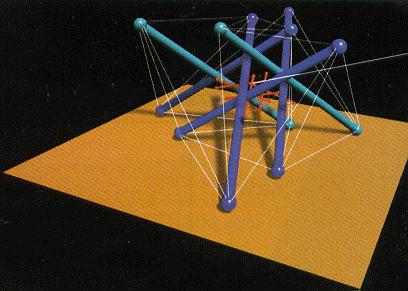

a Tensegrity Model of Cell by Donald Ingber see- The Architecture of Life by D. Ingber
|
|
 |
|
|
|
| tissue culture cells above monolayer have rounded nuclei | - monolayer of cells in tissue culture are flattened |
When the basement cloth is freed from its moorings, thereby making the cell's anchoring surface flexible, the tensegrity model rounds up into its more spherical form, puckering the cloth underneath. The cell's nucleus patterns its shape after that of the tensegrity model in a coordinated fashion. In living cells nuclei spread and flatten out in a similar manner when they adhere to a substrate. Ingber's dowel and elastic string model of a cell, reveals that tensegrity structures may mimic the known behavior of living cells.
Tensegrity Model Structures:
straw models - Camp Elsewhere
- Domes
References :
Donald E.
Ingber - The Architecture of Life, Scientific
American, January 1998
Donald E. Ingber et al - Cellular Tensegrity
and Mechanochemical Transduction,
Annual
Reviews of Physiology, 1997, 19:329-339
Donald E. Ingber - Tensegrity: The Architectural Basis of
Cellular Mechanotransduction,
Annual Review of Physiology,
Vol. 59, pages 575--599; 1997.